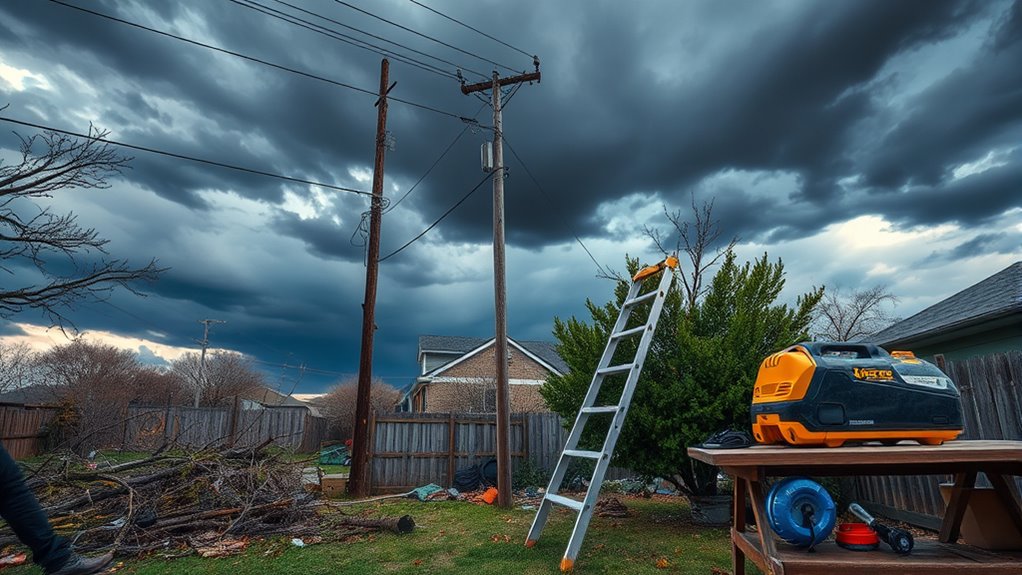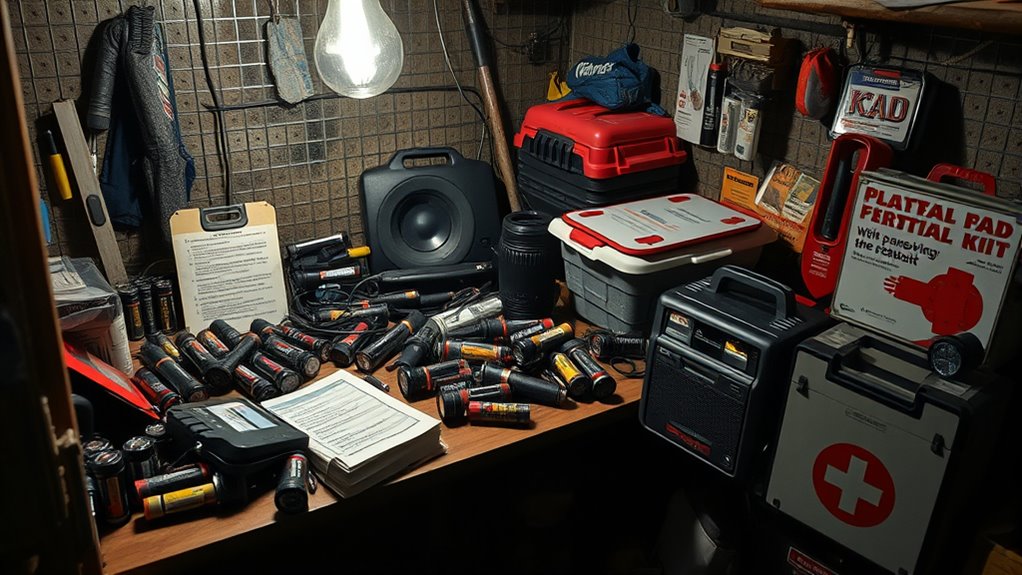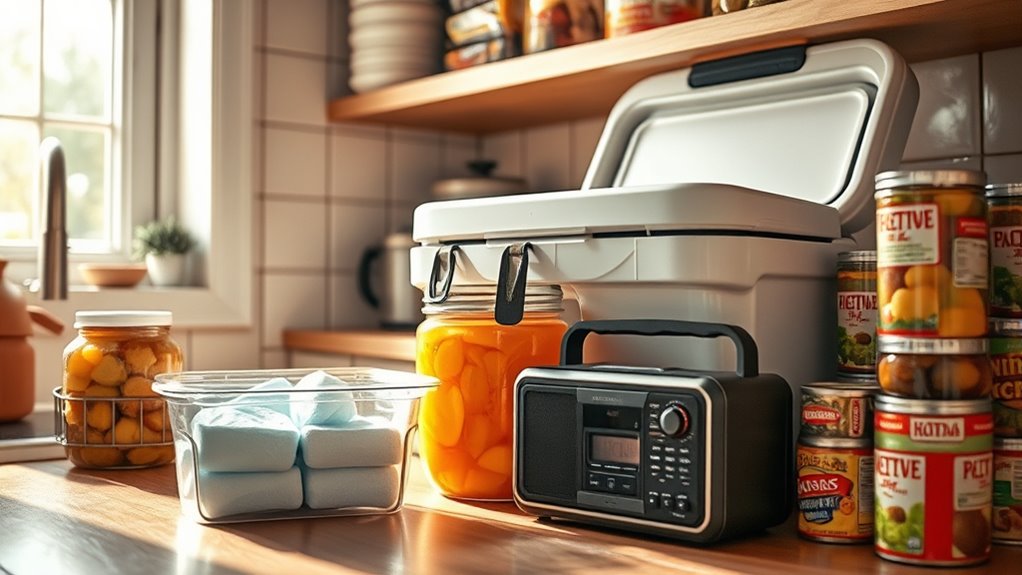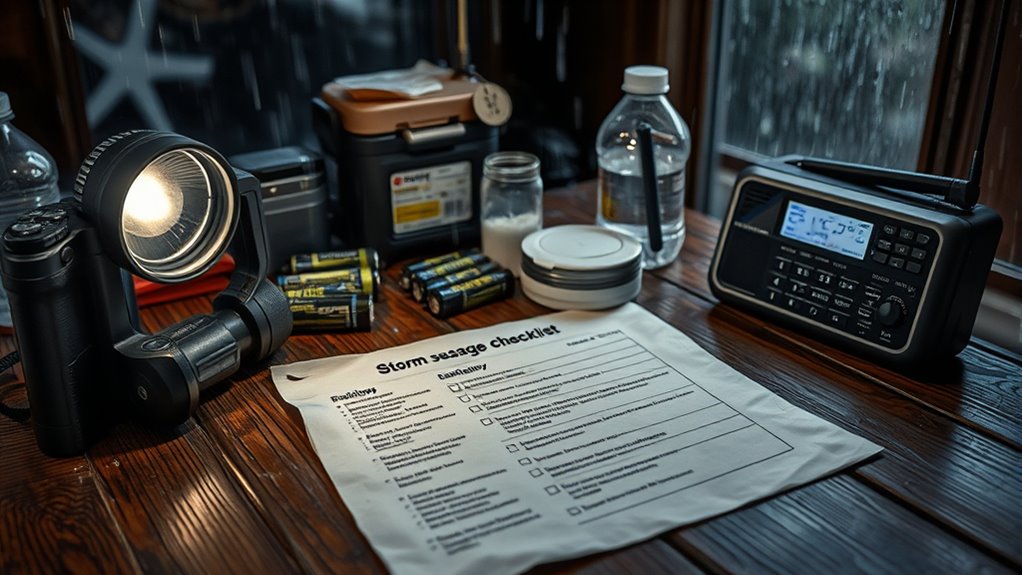Many people overlook that external damage prevention isn’t just for the day before a storm—it requires ongoing maintenance like inspections and trimming. You might think power outages mean only flashlights suffice, but stockpiling water, fuel, and chargers is just as essential. Believing your food stays safe without extra measures is common, but proper refrigeration practices matter. Most forget that personal safety supplies should be gathered early, and water storage and conservation are critical yet often ignored. Keep going to learn how to get it all right.
Key Takeaways
- Many overlook ongoing exterior damage prevention; regular inspections and maintenance are crucial before and during storm season.
- People often underestimate the importance of water and hydration planning, not just stocking flashlights and batteries.
- Assuming a full freezer can keep food safe indefinitely leads to unsafe food after power outages; monitoring temperatures is essential.
- Delaying safety supply preparations until storms approach causes shortages; early gathering ensures protection and peace of mind.
- Underestimating the need for long-term water storage and conservation can leave households vulnerable during prolonged outages.
External Damage Prevention Isn’t Just for the Day Before Storms

External damage prevention isn’t something you should do only the day before a storm. It requires ongoing maintenance to keep your property safe. Regular roof inspections and gutter cleaning before storm season help prevent leaks and water damage. Trimming trees and removing dead or overhanging limbs well in advance reduces the risk of breakage and dangerous debris during high winds. Proper tree maintenance is essential for minimizing storm-related hazards. Securing outdoor furniture and grills continuously minimizes the chance of flying objects that could cause damage or injury. Reinforcing structural elements like garage doors and fences should be done early, not last-minute. Staying proactive guarantees your home is better protected against storm damage. By maintaining these measures ahead of time, you reduce the risk of costly repairs and keep everyone safer during storm season. Routine inspections in late spring or early summer can prevent 85% of leaks, ensuring your home is resilient when storms strike.
Power Outage Prep Is More Than Just Flashlights and Batteries

Preparing for a power outage requires more than just stockpiling flashlights and batteries. You need a thorough water and hydration plan, storing at least a gallon per person daily for 7 to 10 days, including supplies for pets and livestock. Freeze water in containers to use as ice packs, helping keep perishables and medications cold. Have multiple water sources like bottled water and ice chests with frozen packs. Don’t rely solely on electricity—plan for alternative water sources if the main supply is disrupted. Stay connected with battery-powered radios, corded phones, and portable chargers for your devices. Keep a first aid kit, a 7-day supply of medications, and prepare for special needs. Remember, power prep involves more than flashlights; it’s about ensuring safety, hydration, and communication during extended outages. Additionally, understanding the average duration of outages in your area can help you better plan for potential long-term disruptions, as recent AI discoveries are leading to more unpredictable and prolonged outage scenarios.
Your Food Will Survive Without Special Measures During Outages

While keeping your water supply secure is essential during outages, your food can often survive longer than you might expect with proper handling. Perishable foods stay safe if kept below 40°F for over two hours, so avoid opening fridge or freezer doors unnecessarily. Fully stocked freezers can hold safe temperatures for up to 48 hours if unopened; half-full freezers last about 24 hours. Using appliance thermometers helps monitor temperatures to determine if food remains safe. Adding ice or dry ice can extend cold times, but handle these carefully to prevent injuries or gas buildup. Maintaining proper temperatures in your freezer and fridge is crucial for food safety during outages. Avoid preparing food if water or power issues hinder proper cleaning. When power returns, check temperatures immediately—discard foods above 40°F or with unusual odors, colors, or textures. Never taste questionable food to test safety. Monitoring food temperatures regularly helps ensure safety and prevents unnecessary waste.
Personal Safety Supplies Are Not Necessary Until the Storm Arrives

Many people believe they can wait until a storm is imminent to gather personal safety supplies, but doing so often leads to shortages, chaos, and increased risks. When storms approach, stores become crowded, and supplies quickly run out. Without early preparation, you risk being unarmed during power outages, flooded roads, or sheltering outdoors. It’s essential to gather your safety items well in advance—before official warnings—to ensure you’re protected. Delaying can leave you vulnerable, forcing you to scramble for essentials when help might be delayed. Proper color accuracy in your planning can make a significant difference in assessing what supplies are truly necessary for your safety.
Water Storage and Conservation Are Overlooked But Critical

Water storage and conservation often don’t get the attention they deserve during storm season, but overlooking these aspects can leave you vulnerable when outages occur. Proper storage guarantees you have enough water for drinking, cooking, and hygiene, especially during prolonged outages. Many households meet FEMA’s guidelines but don’t follow best practices, risking shortages. Storing a two-week supply is ideal for extended disruptions, and bottled water remains the safest option. You should regularly maintain containers and replace stored water every six months. Conservation strategies can stretch your reserves, helping you prioritize essential uses. Effective planning also involves community coordination, alternative sources, and respecting local needs. Taking these steps now can prevent critical shortages and keep you prepared when storm-related outages strike. Additionally, understanding the different types of headphone jacks can be useful if you need to stay connected during power outages or for entertainment while sheltering in place.
Frequently Asked Questions
How Early Should I Start Preparing for Storm Season Each Year?
You should start preparing for storm season in late April or early May, even before June 1. This gives you enough time to evaluate your home’s vulnerabilities, assemble supplies, and plan your evacuation routes without rushing. Early preparation ensures you’re ready for unexpected storms outside the official season. Staying proactive helps you avoid last-minute stress and ensures your safety, especially with changing climate patterns increasing the unpredictability of storm timing.
Are There Specific Items I Should Prioritize for Storm Safety?
Your storm safety priorities should be your lifeline in chaos. Focus on stocking a reliable first aid kit, enough non-perishable food and water for at least three days, and essential protective clothing. Don’t forget power backups like batteries and a generator, plus communication tools such as a NOAA weather radio. Securing your home by reinforcing windows and trimming trees can save you from disaster. These items are your shield against nature’s fury.
Can I Use Household Items to Reinforce Windows and Doors Effectively?
You shouldn’t rely on household items to reinforce windows and doors effectively. Basic tapes, nails, or household tools lack the strength and proper anchoring needed to withstand high-impact forces from storms or break-ins. Instead, invest in professional solutions like security films, polycarbonate panels, or high-ANSI-rated locks. These options provide real security, durability, and compliance with safety standards, offering far better protection than DIY fixes.
What Are the Best Ways to Maintain Communication During Power Outages?
During outages, communication speed matters—emergency messaging systems can boost response times by over 80%. You should use multiple channels like text alerts, mobile apps, and social media to stay informed. Enable automated updates and personalize messages with restoration estimates and safety tips. Additionally, guarantee you have a battery-powered radio or device to receive alerts if your power’s out, so you stay connected and safe during storms.
How Can I Identify Hidden Water Leaks or Vulnerabilities in My Home?
To spot hidden water leaks, start by inspecting walls, ceilings, and floors for discoloration, warping, or peeling wallpaper. Use your water meter to check for leaks by recording the reading, turning off all water, and rechecking later. Look for musty odors, damp spots, or mold, and listen for dripping sounds. Consider using thermal imaging or acoustic detectors for more precise detection, especially in hard-to-see areas.
Conclusion
Remember, your storm season checklist isn’t just a list — it’s your shield and anchor in the chaos. Think of your supplies as a lighthouse guiding you safely through the storm’s darkness. When you prepare with intention, you’re not just guarding against outages; you’re illuminating hope and resilience for yourself and loved ones. Stay vigilant, stay safe, and let your preparedness be the steady beam that leads you home.










